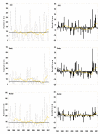The decline in paediatric malaria admissions on the coast of Kenya
- PMID: 18005422
- PMCID: PMC2194691
- DOI: 10.1186/1475-2875-6-151
The decline in paediatric malaria admissions on the coast of Kenya
Abstract
Background: There is only limited information on the health impact of expanded coverage of malaria control and preventative strategies in Africa.
Methods: Paediatric admission data were assembled over 8.25 years from three District Hospitals; Kilifi, Msambweni and Malindi, situated along the Kenyan Coast. Trends in monthly malaria admissions between January 1999 and March 2007 were analysed using several time-series models that adjusted for monthly non-malaria admission rates and the seasonality and trends in rainfall.
Results: Since January 1999 paediatric malaria admissions have significantly declined at all hospitals. This trend was observed against a background of rising or constant non-malaria admissions and unaffected by long-term rainfall throughout the surveillance period. By March 2007 the estimated proportional decline in malaria cases was 63% in Kilifi, 53% in Kwale and 28% in Malindi. Time-series models strongly suggest that the observed decline in malaria admissions was a result of malaria-specific control efforts in the hospital catchment areas.
Conclusion: This study provides evidence of a changing disease burden on the Kenyan coast and that the most parsimonious explanation is an expansion in the coverage of interventions such as the use of insecticide-treated nets and the availability of anti-malarial medicines. While specific attribution to intervention coverage cannot be computed what is clear is that this area of Kenya is experiencing a malaria epidemiological transition.
Figures




References
-
- World Malaria Report 2005. Geneva, Switzerland: Prepared by Roll Back Malaria, World Health Organization and United Nations Children Fund.
Publication types
MeSH terms
Grants and funding
LinkOut - more resources
Full Text Sources
Other Literature Sources
Medical

